
Expressionism is a modernist movement, initially in poetry and painting, originating in Northern Europe around the beginning of the 20th century. Its typical trait is to present the world solely from a subjective perspective, distorting it radically for emotional effect in order to evoke moods or ideas. Expressionist artists have sought to express the meaning of emotional experience rather than physical reality.

Franz Moritz Wilhelm Marc was a German painter and printmaker, one of the key figures of German Expressionism. He was a founding member of Der Blaue Reiter, a journal whose name later became synonymous with the circle of artists collaborating in it.
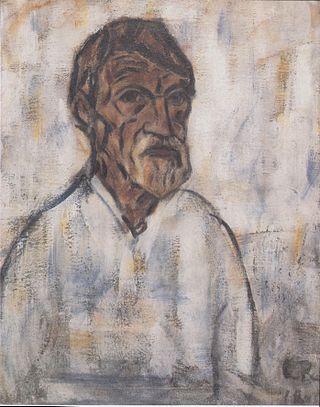
Christian Rohlfs was a German painter and printmaker, one of the important representatives of German expressionism.
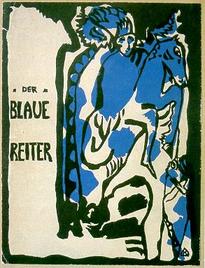
Der Blaue Reiter was a group of artists and a designation by Wassily Kandinsky and Franz Marc for their exhibition and publication activities, in which both artists acted as sole editors in the almanac of the same name, first published in mid-May 1912. The editorial team organized two exhibitions in Munich in 1911 and 1912 to demonstrate their art-theoretical ideas based on the works of art exhibited. Traveling exhibitions in German and other European cities followed. The Blue Rider disbanded at the start of World War I in 1914.

August Robert Ludwig Macke was a German Expressionist painter. He was one of the leading members of the German Expressionist group Der Blaue Reiter. He lived during a particularly active time for German art: he saw the development of the main German Expressionist movements as well as the arrival of the successive avant-garde movements which were forming in the rest of Europe. As an artist of his time, Macke knew how to integrate into his painting the elements of the avant-garde which most interested him. Like his friend Franz Marc and Otto Soltau, he was one of the young German artists who died in the First World War.

Gabriele Münter was a German expressionist painter who was at the forefront of the Munich avant-garde in the early 20th century. She studied and lived with the painter Wassily Kandinsky and was a founding member of the expressionist group Der Blaue Reiter.
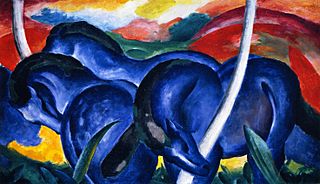
Blue Horses or Die grossen blauen Pferde is a 1911 painting by German painter and printmaker Franz Marc (1880–1916).

Expressionist architecture was an architectural movement in Europe during the first decades of the 20th century in parallel with the expressionist visual and performing arts that especially developed and dominated in Germany. Brick Expressionism is a special variant of this movement in western and northern Germany, as well as in the Netherlands.

Herwarth Walden was a German expressionist artist and art expert in many disciplines. He is broadly acknowledged as one of the most important discoverers and promoters of German avant-garde art in the early twentieth century. He was best known as the founder of the Expressionist magazine Der Sturm and its offshoots.

The Neue Künstlervereinigung München (N.K.V.M.), was an Expressionism art group based in Munich. The registered association was formed in 1909 and prefigured Der Blaue Reiter, the first modernist secession which is regarded as a forerunner and pathfinder for Modern art in 20th-century Germany.

Ludwig Meidner was a German expressionist painter and printmaker born in Bernstadt, Silesia. Meidner is best known for his painted, drawn, and printed portraits and landscapes, but is especially noted for his "apocalyptic" series of work featuring his stylized visions of a pending transformation of Germany before World War I.

The Museum Ostwall is a museum of modern and contemporary art in Dortmund, Germany. It was founded in the late 1940s, and has been located in the Dortmund U-Tower since 2010. The collection includes paintings, sculptures, objects and photographs from the 20th century, plus over 2,500 graphics, spanning Expressionism through classic modern art to the present day.

Heinrich Mathias Ernst Campendonk was a painter and graphic designer born in Germany who became a naturalized Dutch citizen.

Marie Schnür, or Marie Marc-Schnür, was a German painter, illustrator and silhouette maker. From 1907 to 1908, she was married to the painter Franz Marc.
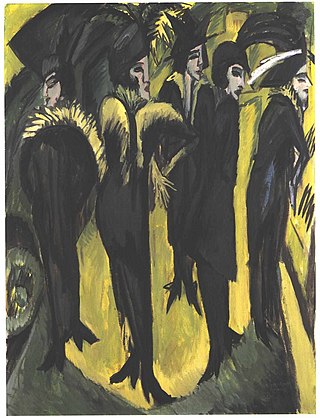
The New Secession was an association of expressionist artists organizing joint exhibitions in Berlin 1910–1914.
Jill Lloyd is a writer and curator specializing in twentieth-century art, with particular expertise for German and Austrian art. She has organised many critically acclaimed exhibitions for leading museums and has published widely, including her book German Expressionism, Primitivism and Modernity, which was awarded the first National Art Book Prize.
Detmar Jobst Wilhelm Westhoff is a German art historian and curator. He is very committed to artistic projects that build a bridge between Asia and Europe, to young experimental artists, local cultural policy and monument protection.

Two Women on the Hillside is an oil-on-canvas painting created in 1906 by German painter Franz Marc. It is part of the Bavarian State Painting Collections and is on a permanent loan at the Franz Marc Museum in Kochel am See.
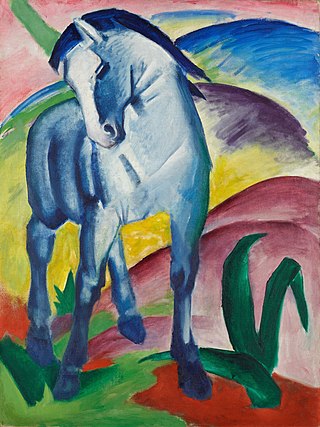
Blue Horse I is an oil painting by Franz Marc completed in 1911. It is one of the painter's most famous works and is part of the collection of the Städtische Galerie im Lenbachhaus in Munich. The painting was part of several exhibitions that Franz Marc and fellow Russian painter Wassily Kandinsky presented to the public under the name Der Blaue Reiter from late 1911 until 1914.

Adolf Erbslöh was a German Expressionist painter; one of the founders of the Neue Künstlervereinigung München.



















